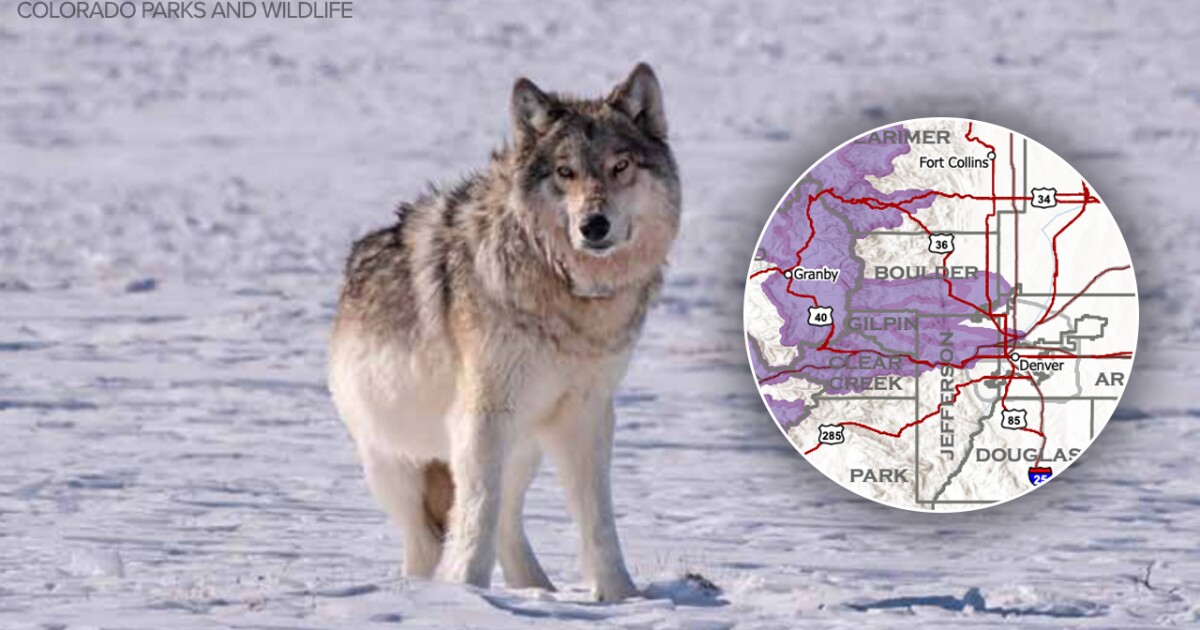DENVER — A new map shows more gray wolf activity along the Front Range than previous records, with at least one animal — if not more — exploring central Boulder County and northern Jefferson County.
According to the latest wolf movement map released by Colorado Parks and Wildlife on Wednesday afternoon, the wolves have been moving around the watersheds northwest of the Denver metro area up toward Boulder and appear closer than ever to the Front Range.
The below map shows watersheds outlined in purple. If it is filled in, it means that at least one collared wolf was within the boundaries for some amount of time between Oct. 21 and Nov. 25. It does not indicate that the wolves are still there.
Colorado Parks and Wildlife
Denver7 zoomed in on the area around the metro to show the watersheds that wolves have entered. However, the watershed boundaries have thick outlines in the above map, so to clear up the lines, Denver7 compared CPW’s map to a USGS watershed map, and drew blue lines around the watersheds that had seen a wolf or wolves in the past month.
USGS
Since the May 2023 approval of the Colorado Wolf Restoration and Management Plan, CPW has said that wolves are expected to expand widely over the years, including to the Front Range.
Two previously released wolf movement maps also revealed wolves nearing the Front Range — March-April 2025 and May-June 2025 — however the animals did not appear to be exploring the region as heavily during those times compared to Wednesday’s new map.
Colorado Parks and Wildlife
These two maps show wolf movements between March-April and May-June 2025, where the animals explored close to the Front Range.
In addition, wolves were detected near tribal lands in Colorado, CPW said on Wednesday. CPW has a memorandum of understanding with the Southern Ute Indian Tribe, the agency said, and it addresses the potential impacts of the wolf reintroduction program on the reservation and Brunot Treaty Area in southwest Colorado.
CPW encourages anybody who has seen a wolf to alert CPW through a form on its website here. It said photos and videos are helpful, and if you are recording a paw print, place an item next to it for size comparison. Coyotes are often mistaken as gray wolves, but the latter are about twice the size and have much larger paw prints — typically 5-inch-long front paws and 4-inch-long back paws.
Colorado Parks and Wildlife
This screenshot of a CPW pamphlet shows the differences between gray wolves and coyotes.
CPW is planning a third round of gray wolf reintroductions in January 2026.
Environment
Gunnison County ranchers bracing for planned 2026 gray wolf reintroduction
Denver7 has been following Colorado’s wolf reintroduction program since the very beginning, and you can explore all of that reporting in the timeline below. The timeline starts with our most recent story.
![]()
Denver7 in-depth wolf coverage
The below list outlines an overview of the known wolf population in Colorado:
Denver7 | Your Voice: Get in touch with Stephanie Butzer
Denver7’s Stephanie Butzer works on the digital team covering stories that have an impact on all of Colorado’s communities, but specializes in reporting on the environment and outdoor recreation. If you’d like to get in touch with Stephanie, fill out the form below to send her an email.

